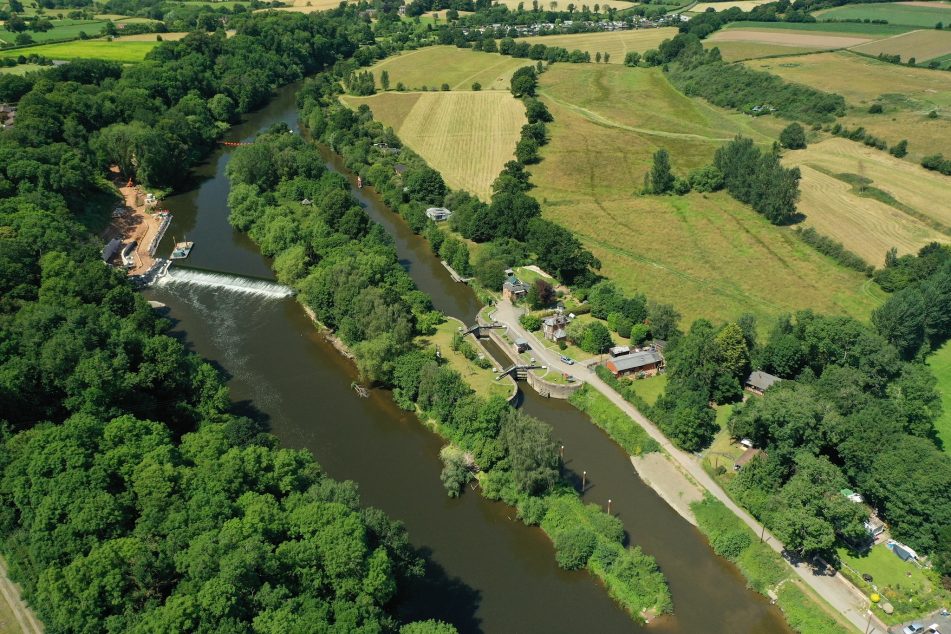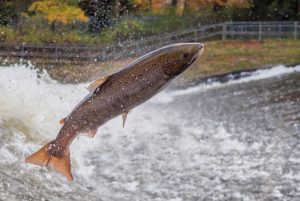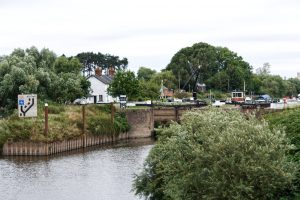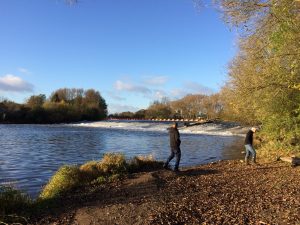
In our first understanding fish passes blog post we covered all the ways in which barriers cause problems for river wildlife. In this second post of the series, we’ll give some context for how pervasive human-made barriers are on our river systems.
Plus we’ll explain why fish can’t simply jump the weir or use the lock gates to get around a barrier, without the need for fish passes! Lastly, we will discuss the gold standard of barrier removal.
Human barriers on rivers – the scale of the problem
The fragmentation of river habitat caused by barriers is one of the five main causes of biodiversity loss in rivers (Baudoin et al., 2014)1. And Europe has probably more heavily modified rivers than anywhere else in the world (AMBER policy Brief 1, September 2020)2. In fact, there are at least 1.2 million in-stream barriers in 36 European countries (Belletti, Garcia, Jones et al., 2020)3.
Shockingly, only 1% of the rivers in England, Scotland and Wales are free of artificial barriers, whilst 97% of the river network in Great Britain is fragmented. This means that on average, there is at least one artificial barrier every 1.5 km of stream in Great Britain (Jones et al, 2019)4.
But can’t fish like salmon just leap over obstacles?
As the statistics above make clear, artificial barriers are a pervasive issue for river wildlife in the modern world. And yet, barriers also produce one of the most iconic and celebrated sights of river fish in the UK, that of salmon jumping.
The salmon has evolved an awesome ability get over obstacles in its path. It is an amazing spectacle to see salmon leaping at weirs or battling their way up through water racing down the weir face. You can see this on the River Severn during the Salmon’s autumn spawning run. But when you understand the phenomenon better, it becomes an uncomfortable watch. Because leaping does not come without a cost, even to salmon. Fuller insight into the salmon’s struggles with these human barriers, makes salmon leaping at weirs a little heart-breaking to witness.
In a natural river system, the salmon’s impressive leaping skills would only come into play right at the end of their spawning migration where boulders and protruding bedrock are natural obstacles in the uppermost reaches of the river. Salmon have evolved a capacity and drive to get past these obstacles found near their spawning grounds. But being forced to struggle over human-made barriers much lower down the river comes at a big cost to salmon. Salmon can be forced to make great efforts to get over artificial barriers in places where the river should still be smooth, easy-swimming. Where the salmon are forced make repeated attempts to get past the barrier before they finally succeed, the energy lost can be huge. In their unsuccessful attempts, the fish can also sustain physical injuries that will impede them on their journey. And the time and persistence required to get past human-made barriers prolongs their epic migration journey.
Fish, like Salmon, who are on their spawning runs are focused on migration, not feeding, so they do not take on board any significant amount of food during their whole journey upriver. Therefore, the longer and more difficult the journey, the more it depletes their finite nutritional reserves. This can have a very direct impact on their spawning success too; stressed females may reabsorb eggs during their migration run, and the eggs themselves may degrade in quality.
Chris Bainger, Environment Agency Fisheries Specialist, recently gave an excellent talk for Unlocking the Severn all about Salmon on the Severn. [Scroll to the bottom of the page to watch the recording.] In his talk, Chris described how he was able to use distinctive markings to identify individual fish in photographs taken of Salmon leaping at Shrewsbury weir. He discovered two particular females, jumping almost every hour, spent nearly four days attempting to pass the weir. A casual observer might assume there were lots of salmon jumping, when in fact, there were only a few individuals making repeated, unsuccessful attempts to cross the weir. It turns out, that what we are actually watching, is a grueling and costly ordeal for these fish.
Not all fish can leap like salmon
And if barriers are such bad news for salmon, we should have a thought for other river fish that are no way near as strong swimmers as salmon are. In fact, most river fish are not physically able to leap like salmon, nor are they as intrinsically motivated to find a way over obstacles. The twaite shad for example, are the endangered anadromous fish that inspired our Unlocking the Severn Project. [For an explanation of the anadromous life cycle see Blog 1.]
Twaite shad can swim fast in short bursts up to 5 metres per second, but they can’t leap out of the water and the 2 metre weir at Diglis in Worcester has been unpassable to shad since it was built in 1844. In fact a series of navigation weirs were built on the River Severn in the mid-1800’s to increase the river depth allowing larger barges to carry industrial goods more easily. These weirs have prevented shad from accessing quality spawning habitats between Worcester and Welshpool ever since.
Twaite shad are sea-dwelling fish, part of the herring family. They migrate up the River Severn every spring to spawn. As a result of losing access to their spawning grounds, the population of twaite shad dramatically crashed within just a few years. And only a residual population has survived, returning to the River Severn each year to spawn as best they can in the lower reaches.
Why can’t the fish use the locks to get around the weir like the boats do?
Weirs are a wall built right across the river. That wall will block boats as well as fish! So, on navigable sections of river, Victorian engineers cut man-made channels to install locks alongside weirs. Boaters simply follow the signs around to new side channel where the locks allow them to move their boat between the different river levels up and downstream of the weir. Unfortunately, however, fish don’t know the side channel is the route past the weir. Fish may have some pretty amazing adaptations, but reading navigation signage isn’t one of them!
In fact, the way a fish ‘reads’ the river is through sensing the flows and currents through pressure receptors on its body. Anadromous fish that are motivated to migrate long distances upstream for spawning are particularly tuned in to follow the flow of the river. ‘Dead water’ such as that sitting in front of a closed lock gate therefore has no appeal to a migrating fish. Attracted to the flow of water cascading over the weir, they will simply swim right past the lock gates. And they are destined for frustration when they can’t find a way through.
Why don’t you take out the weirs?
In an ideal world, for the benefit of wildlife, we’d be able to take out all artificial barriers and return a river to its natural free-flowing state. As well as impeding the movement of fish, barriers impact other organisms too such as river insects in their nymph and larval stages and aquatic plants, affect the natural transport of sediment in the river, and change the flow of water, which all affects the quality of river habitats for wildlife up and down stream. However, human settlements have through history, often grown up around rivers. Rivers have always provided important resources to humans: a ready source of water for drinking and manufacturing, fish for food, and the river cuts a channel through the landscape for easy transport. So, our towns and cities have grown up around rivers as important conduits for trade.
In built up areas, it is not always possible to remove historic barriers that have been in place for many generations. On the River Severn, the weirs were built to improve the river navigation for barges carrying raw materials and industrial goods. Whilst boat traffic on the River Severn is almost exclusively leisure-based these days, the status of the River Severn as a managed navigation for boats is still protected by an Act of Parliament. Our project has therefore focused on providing the very best fish passes we can, rather than try to change the way that people use the River Severn or end the river’s long history of navigation by boats.
In our next blog post in the series you can learn how some fish passes are better than others, and what factors are critical to ensure their success. However, on smaller or more remote rivers, or where barriers are obsolete, removing the artificial barriers entirely remains the best solution for wildlife. The healthiest river ecosystems will always be those that are naturally free flowing – watch the World Fish Migration documentary below to get inspired.
Further Reading & Watching:
Chris Bainger’s talk about Salmon on the River Severn and the challenges they face.
If you watch one documentary about fish migration, make it this one:
Further articles about the need for barrier removal:
References for this blog post:
1. Baudoin et al. (2014) The ICE protocol for ecological continuity. Assessing the passage of obstacles by fish. Concepts, design and application. ONEMA, The National Agency for Water and Aquatic Environments, ISBN:979-10-91047-29-6. As referenced in Amber. [As referenced in: AMBER Consortium (2020). Impacts of Barriers on Biodiversity of Running Waters. AMBER Policy Brief No 3., 14 pp. https://amber.international/policy-briefs/ Direct Link: https://amber.international/wp-content/uploads/2020/11/AMBER-Policy-Brief-3.pdf]
2. AMBER Consortium (2020). AMBER Policy Brief No 1., 11 pp. https://amber.international/policy-briefs/
3. Belletti, B., Garcia de Leaniz, C., Jones, J. et al.More than one million barriers fragment Europe’s rivers. Nature 588, 436–441 (2020). https://doi.org/10.1038/s41586-020-3005-2
4. Jones, J et al, (2019). A comprehensive assessment of stream fragmentation in Great Britain. Science of The Total Environment, 673, 756-762. https://doi.org/10.1016/j.scitotenv.2019.04.125




